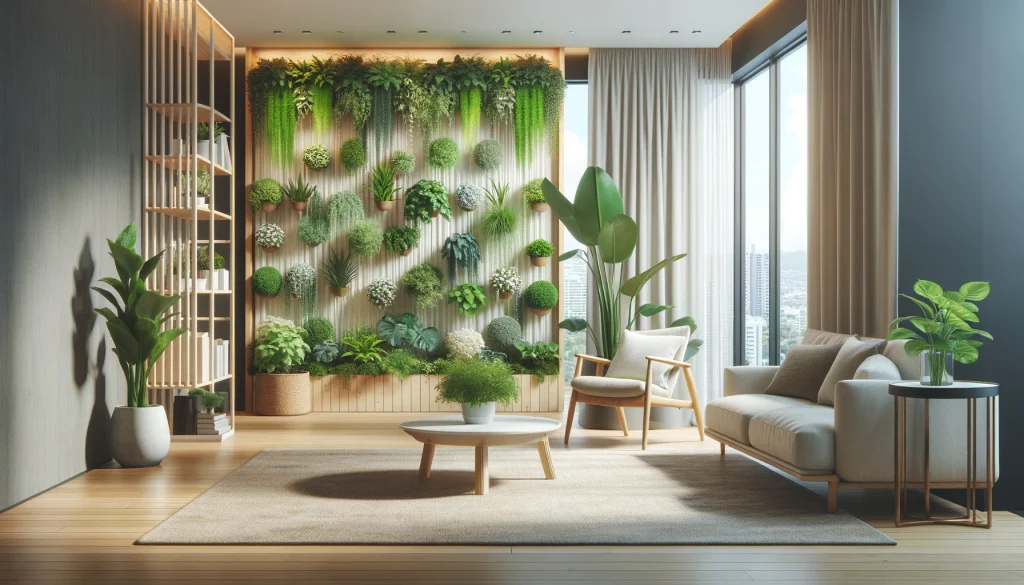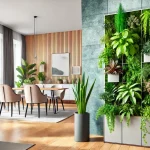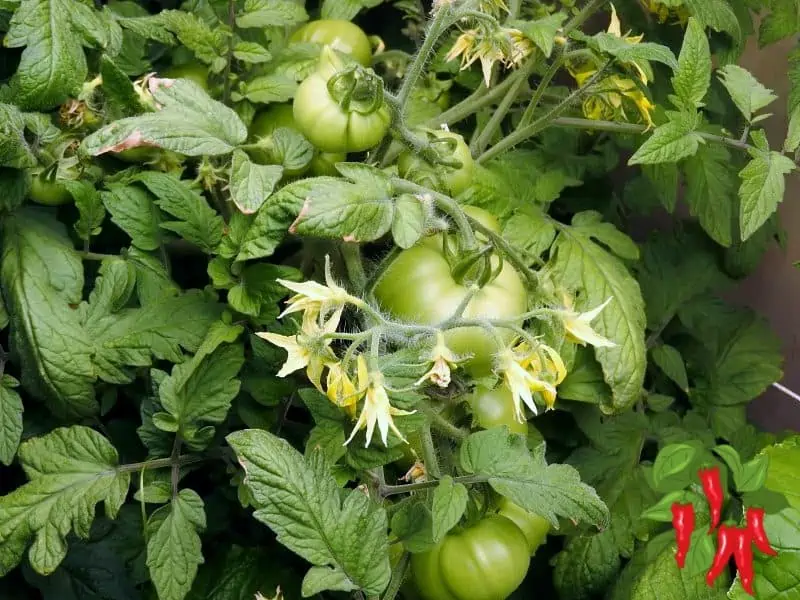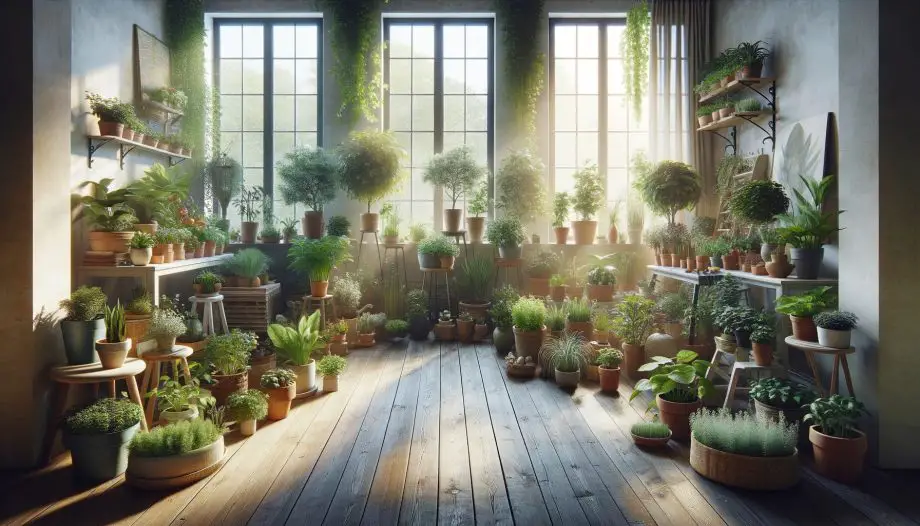This post may contain affiliate links. If you buy something from one of our links we may earn a commission. Thanks

Indoor Vertical Gardening Key Takeaways
- Indoor Vertical Gardening is a method of growing plants upwards, using vertical space efficiently.
- Perfect for small homes, it enhances air quality and decor.
Indoor Vertical Gardening
Indoor vertical gardening is a fantastic way to bring the beauty and benefits of nature into your home, even in small spaces.
Whether you’re a seasoned gardener or just starting, this method makes growing plants indoors both fun and practical.
Ready to transform your living space into a lush green oasis?
Designing Vertical Gardens Indoors
Creating an indoor vertical garden is a fun and rewarding way to bring some green into your home.
It’s amazing how even a small space can be transformed into a lush, living wall.
Let’s dive into how to design your perfect vertical garden indoors with some simple and practical steps.
Space assessment and planning
- Measure your available space carefully.
- Consider both height and width for your garden.
- Think about the weight your wall can support.
- Plan for access to water and light sources.
Choosing the right location
- Pick a spot with good natural light.
- Avoid areas with extreme temperatures.
- Ensure the location is easily accessible for maintenance.
- Consider how close it is to your water supply.
Design styles and aesthetics
- Choose a design that matches your home’s decor.
- Think about the colors and textures of the plants.
- Decide between a uniform look or a mix of different plants.
- Incorporate elements like shelves or hanging pots.
Incorporating vertical gardens into existing decor
- Blend the garden with your current furniture and decorations.
- Use complementary colors to enhance the room’s look.
- Add decorative elements like lights or small sculptures.
- Make the garden a focal point of the room.
Ready to get started? A little planning goes a long way in creating a beautiful and thriving indoor vertical garden.
Suitable Plants for Vertical Gardening
Choosing the right plants is key to a successful indoor vertical garden. Not all plants thrive in the same conditions, so it’s important to pick ones that will do well in your specific setup.
Read more: Best Plants for Vertical Gardening: 10 Vertical Garden Tips – Stay Green Garden
Let’s explore some great options for your vertical garden that will keep it looking vibrant and healthy.
Best plants for low light conditions
- Pothos: Hardy and adaptable, perfect for low light.
- Snake plant: Survives with minimal sunlight.
- Philodendron: Thrives in indirect light.
- Ferns: Great for shaded areas, adding lush greenery.
Fast-growing vs. slow-growing plants
- Fast-growing: Herbs like basil and mint; they fill spaces quickly and are easy to manage.
- Slow-growing: Succulents and cacti; require less maintenance and grow steadily over time.
- Combination: Mix both for a balanced and dynamic vertical garden.
Edible plants for vertical gardens
- Herbs: Basil, parsley, and mint are easy to grow and useful in the kitchen.
- Leafy greens: Lettuce, spinach, and kale can be harvested continuously.
- Small fruits: Strawberries and cherry tomatoes add color and flavor.
Flowering plants and their care
- Orchids: Need bright, indirect light and regular watering.
- Begonias: Thrive in low light and require consistent moisture.
- Impatiens: Perfect for shaded areas, with vibrant blooms.
- Care tips: Regular deadheading, proper watering, and ensuring enough light for blooms.
Selecting the right plants can make all the difference in your vertical garden. Whether you want low-maintenance greenery, quick harvests, or beautiful flowers, there’s a plant for every need.
Irrigation Solutions for Vertical Gardens
Keeping your vertical garden properly watered is essential for its success. Different setups may require different irrigation methods, so it’s good to know your options.
Let’s look at some effective ways to ensure your plants get the water they need.
Drip irrigation systems
- Efficiency: Delivers water directly to the roots.
- Customization: This can be tailored to different plant needs.
- Automation: Easily set up with timers for consistent watering.
- Installation: Requires some initial setup but saves time in the long run.
Self-watering planters
- Convenience: Ideal for busy schedules.
- Reservoir system: Plants draw water as needed from a built-in reservoir.
- Maintenance: Fewer refills compared to traditional watering.
- Suitability: Great for small plants and herbs.
Manual watering techniques
- Control: Allows you to monitor plant health closely.
- Flexibility: Adjust watering based on daily plant needs.
- Tools: Use watering cans or hoses with gentle spray nozzles.
- Frequency: Regular checks to ensure consistent moisture levels.
Water conservation methods
- Mulching: Helps retain soil moisture and reduce evaporation.
- Rainwater harvesting: Collect and use rainwater for your garden.
- Hydrogels: These water-absorbing crystals can be mixed with soil to retain moisture.
- Efficient watering: Water in the early morning or late evening to minimize evaporation.
Choosing the right irrigation solution can make all the difference in maintaining a healthy vertical garden.
Whether you prefer automation, self-watering systems, or manual techniques, there’s an option to fit your lifestyle and garden needs.
DIY Vertical Garden Frames
Building your own vertical garden frame is a rewarding project that lets you customize your garden to fit your space and style.
Plus, it’s a fun way to get hands-on with your gardening. Let’s walk through how to create a sturdy and attractive vertical garden frame.
Materials needed for building frames
- Wood: Sturdy and easy to work with.
- Metal pipes: Durable and can support heavier plants.
- PVC pipes: Lightweight and versatile.
- Fasteners: Screws, nails, and brackets for assembly.
- Tools: Saw, drill, measuring tape, and screwdriver.
Step-by-step construction guides
- Measure and cut: Measure your space and cut the materials to size.
- Assemble the frame: Use screws or brackets to connect the pieces.
- Add shelves or supports: Attach horizontal supports for planters.
- Secure the frame: Mount the frame to the wall or ensure it’s free-standing.
- Check for stability: Ensure everything is secure and sturdy.
Tips for stability and durability
- Anchoring: Secure the frame to a wall or sturdy base.
- Reinforcement: Add extra supports if you’re using heavy planters.
- Weatherproofing: Treat wood to protect against moisture.
- Regular checks: Periodically check for and fix any loose parts.
Customizing frames for aesthetics
- Paint or stain: Match the frame color to your room’s decor.
- Decorative elements: Add hooks, lights, or small decorative items.
- Plant variety: Mix different plants for a vibrant look.
- Personal touches: Incorporate elements like family photos or small art pieces.
Creating your own vertical garden frame lets you design a setup that fits perfectly in your home.
With the right materials and a little bit of effort, you can build a beautiful and functional garden that will bring life to any space.
Pre-fabricated Vertical Garden Kits
If you’re looking for a quick and easy way to start your indoor vertical garden, pre-fabricated kits are a fantastic option.
They come with everything you need to get started and often include some helpful features.
Let’s dive into the top brands, installation tips, cost comparisons, and user experiences.
Top brands and their features
- Living Wall Planters: Known for their modular and flexible designs. They use breathable fabric pockets that are easy to install.
- Vertical Gardens: Offers sturdy, stackable units that are great for small spaces.
- Living Wall Planter – Self Watering: Features self-watering designs and a sleek, modern look. They are perfect for herbs and small plants.
- Click and Grow: A smart garden system that uses automated watering and lighting. Ideal for tech-savvy gardeners.
Installation process
- Unpack the kit: Lay out all the parts and read the instructions carefully.
- Assemble the frame: Follow the guide to put together the main structure.
- Mounting: Secure the frame to your chosen wall or set it up as a free-standing unit.
- Add plants: Fill the pockets or planters with soil and plants.
- Watering system: Connect any built-in irrigation systems and ensure they are working properly.
Comparing costs and benefits
- Initial investment: Kits range from budget-friendly to high-end, depending on materials and features.
- Convenience: Pre-fabricated kits save time and effort compared to DIY setups.
- Longevity: Higher-quality kits often last longer and require less maintenance.
- Customization: Some kits offer limited customization, while others can be expanded or modified.
User reviews and experiences
- Positive feedback: Many users appreciate the ease of installation and the stylish designs of pre-fabricated kits.
- Challenges: Some users report issues with durability or the need for additional support.
- Success stories: Plenty of gardeners share how these kits have transformed their indoor spaces into green havens.
- Tips from users: Reading reviews can provide insights into the best ways to use and maintain these systems.
Pre-fabricated vertical garden kits offer a convenient and stylish solution for those wanting to bring a touch of green indoors without the hassle of building from scratch.
Whether you’re a beginner or an experienced gardener, there’s likely a kit out there that fits your needs perfectly.
Maintenance of Vertical Gardens
Keeping your vertical garden healthy and thriving requires regular maintenance. It might sound like a lot, but with a little know-how, it’s quite manageable.
Here’s how to keep your garden in tip-top shape all year round.
Regular pruning and trimming
- Encourage growth: Regular pruning helps plants grow more vigorously.
- Shape and size: Trim to maintain the desired shape and size of your plants.
- Remove dead parts: Cut away any dead or yellowing leaves to keep plants healthy.
- Tools: Use clean, sharp scissors or pruners for the best results.
Pest and disease control
- Regular checks: Inspect plants regularly for signs of pests or disease.
- Natural remedies: Use neem oil or insecticidal soap to treat common pests like aphids or spider mites.
- Disease prevention: Ensure proper air circulation and avoid overwatering to prevent mold and mildew.
- Isolation: Quarantine any infected plants to prevent the spread to others.
Soil and substrate care
- Nutrient management: Feed your plants with the right fertilizers according to their needs.
- Replace soil: Refresh the soil or substrate periodically to prevent compaction and nutrient depletion.
- Drainage: Ensure your soil mix has good drainage to prevent root rot.
- Mulching: Add a layer of mulch to retain moisture and reduce weed growth.
Seasonal maintenance tasks
- Adjust lighting: Change the position or type of lighting as natural light availability changes with the seasons.
- Watering schedule: Adjust your watering frequency depending on the temperature and humidity.
- Seasonal pruning: Trim back plants more aggressively in the growing season and lightly during dormancy.
- Protect from cold: If temperatures drop, ensure your indoor garden stays warm enough for your plants.
With regular care, your vertical garden will not only survive but thrive, providing beauty and greenery to your home all year long.
It’s all about consistency and paying attention to your plants’ needs. Happy gardening!
Benefits of Vertical Indoor Gardening
Vertical indoor gardening offers many perks that make it a fantastic addition to any home.
Not only does it allow you to grow more plants in limited space, but it also brings several health and aesthetic benefits.
Let’s explore why vertical gardening might be the perfect solution for your home.
Maximizing small spaces
- Efficient use of space: Vertical gardens make the most of small areas by growing upwards.
- More plants: Fit more greenery into compact spaces like apartments or offices.
- Flexibility: Vertical setups can be placed in various locations, from walls to corners.
- Accessibility: Easier to reach and maintain compared to traditional gardens.
Read more about indoor vertical gardens for apartments
Improving indoor air quality
- Natural air filters: Plants help remove toxins from the air, improving overall air quality.
- Oxygen production: More plants mean more oxygen, leading to a fresher indoor environment.
- Humidity regulation: Plants release moisture, which can help maintain a comfortable humidity level indoors.
- Health benefits: Cleaner air can reduce allergies and respiratory issues.
Enhancing home aesthetics
- Visual appeal: Vertical gardens add a unique and beautiful element to home decor.
- Customization: Choose plants and designs that complement your home’s style.
- Living art: Create a dynamic, ever-changing piece of living art.
- Color and texture: Add variety and interest to any room with different plants and arrangements.
Reducing stress and boosting mood
- Calming effect: Being around plants has been shown to reduce stress levels.
- Mood enhancement: The presence of greenery can boost your mood and overall well-being.
- Therapeutic activity: Gardening itself can be a relaxing and rewarding hobby.
- Connection to nature: Bringing nature indoors helps create a peaceful and serene environment.
Vertical indoor gardening isn’t just about saving space; it’s about creating a healthier, more beautiful, and happier home.
Whether you’re looking to breathe easier, enjoy some greenery, or simply add a touch of nature to your decor, vertical gardening has something to offer.
Vertical Garden Health and Safety
Creating a vertical garden involves more than just planting; you also need to ensure it’s safe and healthy for everyone in your home.
Here are some essential tips to keep your garden secure and thriving.
Safe installation practices
- Proper anchoring: Securely mount the garden to a wall or use a stable free-standing structure.
- Weight considerations: Make sure the wall or structure can support the weight of the plants and soil.
- Tools and materials: Use the right tools and high-quality materials to prevent accidents.
- Follow instructions: Adhere to manufacturer guidelines if using pre-fabricated kits.
Child and pet-friendly options
- Non-toxic plants: Choose plants that are safe for children and pets, avoiding toxic varieties like pothos or philodendron.
- Stable setup: Ensure the garden is stable and cannot be easily tipped over by curious kids or pets.
- Accessibility: Place the garden in a spot that’s out of reach of young children and pets if necessary.
- Safe materials: Avoid sharp edges and use smooth, safe materials.
Preventing mold and mildew
- Proper ventilation: Ensure good air circulation around the plants to prevent mold growth.
- Water management: Avoid overwatering and ensure proper drainage to reduce excess moisture.
- Regular checks: Inspect plants and soil regularly for signs of mold or mildew.
- Cleaning: Clean any mold or mildew promptly to prevent spread.
Ensuring structural integrity
- Regular inspections: Check the frame and mounting points periodically for signs of wear or damage.
- Reinforcements: Add extra supports if needed to handle the weight of mature plants.
- Material maintenance: Treat wood against moisture and check for rust on metal parts.
- Professional help: Consider consulting a professional for installation if you’re unsure about the structure’s stability.
By following these health and safety tips, you can enjoy your vertical garden without worry.
It’s all about creating a secure, healthy environment for both your plants and your household. Happy gardening!
Structural Considerations for Vertical Gardens
When setting up a vertical garden, it’s important to think about the structure and support.
Ensuring your garden is safe and well-built will help it thrive. Here’s what you must consider to strengthen your vertical garden.
Learn how to build a vertical succulent garden.
Weight distribution and support
- Balanced weight: Evenly distribute the weight of plants and soil across the structure.
- Support systems: Use sturdy frames or brackets to support heavier plants.
- Shelving: Consider adjustable shelves to manage weight and plant growth.
- Plant selection: Choose lighter plants for higher levels and heavier ones for lower levels.
Wall protection and moisture barriers
- Waterproofing: Use waterproof liners or barriers to protect walls from moisture.
- Wall mounts: Ensure mounts are secure and designed to handle the weight and moisture.
- Drainage systems: Incorporate effective drainage to prevent water buildup.
- Moisture-resistant materials: Use materials like treated wood or metal to withstand damp conditions.
Selecting the right hardware
- Quality fasteners: Use high-quality screws, anchors, and brackets for secure mounting.
- Weight rating: Ensure all hardware can handle the weight of the garden.
- Corrosion resistance: Choose rust-resistant hardware, especially for outdoor or humid environments.
- Compatibility: Ensure hardware matches the materials and structure of your garden frame.
Professional vs. DIY installation
- DIY benefits: Cost-effective, customizable, and rewarding for hands-on gardeners.
- Professional help: Ideal for complex or large installations, ensures safety and durability.
- Hybrid approach: Combine DIY efforts with professional advice for best results.
- Assessment: Consider your skills, tools, and time before deciding on DIY or professional installation.
Getting the structure right is crucial for a successful vertical garden. By considering weight distribution, protecting your walls, using the right hardware, and choosing between DIY and professional help, you can create a garden that’s both beautiful and secure.
Integrating Art with Vertical Gardens
Combining art with vertical gardening can turn a simple plant wall into a stunning focal point.
By creatively blending greenery with artistic elements, you can enhance both the aesthetic and functional aspects of your indoor garden.
Here are some ways to integrate art into your vertical garden.
Using decorative pots and planters
- Colorful pots: Choose pots in vibrant colors to add a splash of color.
- Unique designs: Look for pots with interesting patterns or textures.
- Handmade options: Consider using handmade or custom-designed planters for a personal touch.
- Mix and match: Combine different styles and sizes for a dynamic look.
Adding sculptures and ornaments
- Small statues: Place small sculptures among the plants for added interest.
- Hanging ornaments: Use hanging decorations like wind chimes or mobiles.
- Themed decor: Match ornaments to the theme of your room or garden.
- Materials: Choose weather-resistant materials like metal or resin for durability.
Creative plant arrangements
- Patterned planting: Arrange plants in geometric patterns or shapes.
- Color coordination: Group plants by color for a striking visual effect.
- Texture play: Mix plants with different textures to add depth.
- Vertical layers: Use taller plants at the top and trailing plants at the bottom for a cascading effect.
Lighting effects and accents
- Spotlights: Use spotlights to highlight specific plants or areas.
- String lights: Drape string lights around the garden for a magical glow.
- Colored lights: Experiment with colored lights to create different moods.
- Adjustable lighting: Use adjustable lighting to change the focus and enhance growth.
Integrating art with your vertical garden can make your space more enjoyable and visually appealing.
Whether it’s through decorative pots, sculptures, creative arrangements, or lighting, there are endless ways to add your personal touch and create a unique garden masterpiece.
Seasonal Changes and Vertical Gardens
Seasonal changes can have a big impact on your vertical garden, and knowing how to adapt will keep your plants healthy year-round.
From choosing the right plants to adjusting your care routine, let’s look at how to handle the different seasons in your vertical garden.
Adapting to different seasons
- Temperature control: Use heaters or fans to maintain a stable temperature.
- Light adjustments: Supplement natural light with grow lights in winter.
- Humidity management: Use humidifiers or dehumidifiers to maintain optimal humidity levels.
- Air circulation: Ensure good air circulation to prevent mold and pests.
Seasonal plant choices
- Spring and summer: Opt for fast-growing, sun-loving plants like herbs and tomatoes.
- Fall: Choose hardy plants that can handle cooler temperatures, such as kale and chard.
- Winter: Go for low-light, cold-tolerant plants like ferns and ivy.
- Year-round options: Some plants, like pothos and philodendrons, thrive in any season with proper care.
Adjusting care routines
- Watering: Increase watering frequency in summer and reduce it in winter.
- Fertilizing: Use a balanced fertilizer during the growing season and reduce feeding in dormant periods.
- Pruning: Trim back plants more aggressively in spring and summer to encourage growth.
- Pest control: Be vigilant for seasonal pests and treat them promptly.
Preparing for extreme weather conditions
- Heatwaves: Provide extra shade and increase watering to prevent heat stress.
- Cold snaps: Bring sensitive plants indoors or use frost covers to protect them.
- Storms: Secure your vertical garden structure to prevent damage from high winds.
- Drought: Implement water-saving techniques like mulching and using drought-tolerant plants.
By adapting your vertical garden to the changing seasons, you can ensure that it remains a thriving and vibrant part of your home.
Seasonal adjustments in plant selection and care routines are key to maintaining a healthy and beautiful garden all year long.
Plant Selection and Placement
Choosing the right plants and placing them correctly is crucial for a thriving vertical garden.
Whether you’re working with low light or lots of sunshine, mixing different types of plants can create a stunning and healthy display. Here’s how to get it right.
Light requirements and plant placement
- Assess light levels: Identify areas with direct, indirect, or low light.
- Place accordingly: Position sun-loving plants like herbs and succulents in brighter spots.
- Shade plants: Use low-light plants like ferns and philodendrons in shaded areas.
- Rotating plants: Move plants around occasionally to ensure even light exposure.
Mixing and matching plant types
- Variety: Combine different types of plants (foliage, flowering, and edible) for a dynamic look.
- Height differences: Use tall plants at the top and shorter ones at the bottom to create layers.
- Color contrast: Mix plants with different leaf colors and textures for visual interest.
- Growth rates: Combine fast-growing plants with slower ones to maintain balance.
Creating visual balance
- Symmetry: Arrange plants symmetrically for a formal, balanced look.
- Asymmetry: For a more natural look, place plants asymmetrically but ensure visual harmony.
- Repetition: Repeat certain plants or colors throughout the garden to create cohesion.
- Focal points: Use striking plants or decorations as focal points to draw the eye.
Companion planting for health and growth
- Beneficial pairings: Pair plants that support each other’s growth, like basil and tomatoes.
- Pest control: Use companion plants that repel pests, such as marigolds with vegetables.
- Nutrient sharing: Combine plants with different nutrient needs to avoid competition.
- Space optimization: Use vining plants with bushy plants to maximize vertical space.
By carefully selecting and placing your plants, you can create a beautiful and healthy vertical garden that thrives in its environment.
The right combination of light, variety, visual balance, and companion planting will ensure your garden looks great and grows well.
Nutrient Management in Vertical Gardens
Proper nutrient management is essential for keeping your vertical garden healthy and productive.
With the right fertilization schedule and understanding of nutrient types, you can ensure your plants get everything they need.
Let’s explore how to manage nutrients effectively in your vertical garden.
Fertilization schedules
- Regular feeding: Fertilize every 2-4 weeks during the growing season.
- Dormant periods: Reduce or stop fertilizing during the winter months.
- Specific needs: Adjust the schedule based on plant type and growth stage.
- Liquid vs. slow-release: Use liquid fertilizers for quick absorption or slow-release granules for consistent feeding.
Organic vs. synthetic nutrients
- Organic nutrients: Derived from natural sources like compost, manure, and bone meal. They improve soil health and provide a slow, steady release of nutrients.
- Synthetic nutrients: Manufactured chemicals that provide immediate nutrient availability. They are easy to apply and control but may not improve soil structure.
- Combination approach: Many gardeners use a mix of both to balance immediate needs and long-term soil health.
Signs of nutrient deficiencies
- Yellowing leaves: Often indicates a lack of nitrogen.
- Stunted growth: Can be due to phosphorus deficiency.
- Purple or red leaves: May signal a lack of phosphorus or nitrogen.
- Poor flowering or fruiting: Often a sign of potassium deficiency.
- Browning edges: Could indicate a lack of potassium or over-fertilization.
Soil amendments and enhancements
- Compost: Adds organic matter and improves soil structure and fertility.
- Worm castings: Rich in nutrients and beneficial microbes.
- Bone meal: A great source of phosphorus for root and flower development.
- Epsom salts: Provide magnesium, essential for photosynthesis.
- Rock dust: Adds trace minerals and micronutrients.
By managing the nutrients in your vertical garden carefully, you can ensure your plants grow strong and healthy.
Regular fertilization, understanding nutrient types, recognizing deficiency signs, and using soil amendments will keep your garden lush and productive.
Lighting Solutions for Vertical Settings
Proper lighting is crucial for the health and growth of your vertical garden.
Different plants have different light needs, and using the right lighting solutions can make a big difference.
Here’s how to ensure your vertical garden gets the light it needs to thrive.
Types of grow lights
- LED lights: Energy-efficient and long-lasting, offering a full spectrum of light.
- Fluorescent lights: Good for smaller setups, available in T5 and T8 sizes.
- HID lights: High-intensity discharge lights are powerful but generate a lot of heat.
- CFL bulbs: Compact fluorescent lights are suitable for small spaces and seedlings.
Positioning lights for optimal growth
- Distance: Keep lights at the right distance from plants to avoid burning or stretching.
- LEDs: 12-24 inches above the plants.
- Fluorescent: 6-12 inches above the plants.
- HID: 24-36 inches above the plants.
- Angle: Position lights to cover the entire plant area evenly.
- Adjustability: Use adjustable fixtures to change light height as plants grow.
- Reflectors: Use reflectors or white walls to maximize light efficiency.
Light cycles and plant health
- Seedlings: 16-18 hours of light per day to encourage growth.
- Vegetative stage: 14-16 hours of light per day.
- Flowering stage: 12 hours of light and 12 hours of darkness to promote blooming.
- Consistency: Maintain regular light cycles to avoid stressing plants.
- Timers: Use timers to automate light cycles and ensure consistency.
Energy-efficient lighting options
- LED lights: Use less electricity and produce less heat, making them the most energy-efficient option.
- CFL bulbs: More efficient than traditional incandescent bulbs and suitable for small setups.
- Fluorescent lights: T5 fixtures are particularly energy-efficient and good for low light setups.
- Dimmable options: Consider dimmable lights to adjust intensity and save energy.
Choosing the right lighting solutions for your vertical garden can significantly impact plant health and growth.
By selecting appropriate grow lights, positioning them correctly, managing light cycles, and opting for energy-efficient options, you can create an ideal growing environment for your indoor plants.
Indoor Climbing Plants
Indoor climbing plants can add a lush, green aesthetic to your home, turning any vertical space into a living wall.
With the right plants and support, you can create a beautiful indoor jungle. Here’s how to choose and care for indoor climbers.
Best climbing plants for indoors
- Pothos: Hardy and versatile, perfect for low light and easy to train.
- Philodendron: Heartleaf varieties are especially good climbers.
- Ivy: English ivy thrives indoors and adapts well to various light conditions.
- String of Hearts: Delicate and beautiful, great for hanging baskets and vertical gardens.
- Climbing fig (Ficus pumila): A fast grower that clings well to supports.
Training plants to climb
- Start early: Begin training plants while they are young and flexible.
- Guidance: Use soft ties or clips to gently guide stems in the desired direction.
- Regular adjustment: Check and adjust ties regularly to avoid constriction.
- Encouragement: Pinch back new growth to encourage bushiness and more climbing stems.
Supporting structures and trellises
- Trellises: Install trellises against walls or in pots to give plants something to climb.
- Poles and stakes: Use moss poles or stakes in pots for support.
- Wires and strings: Create a network of wires or strings for plants to climb on walls.
- Wall-mounted grids: Attach grids or lattice panels to walls for a structured climbing area.
Care and maintenance of climbers
- Pruning: Regularly prune to control size and encourage fuller growth.
- Watering: Keep the soil consistently moist but not waterlogged.
- Feeding: Fertilize monthly during the growing season with a balanced fertilizer.
- Humidity: Many climbers prefer higher humidity; use a humidifier or mist regularly.
- Pest control: Check for pests like spider mites and treat promptly.
Indoor climbing plants can transform your home into a green oasis.
By selecting the best climbers, providing proper training and support, and maintaining their care, you’ll enjoy a thriving vertical garden that brings life and beauty to your space.
Vertical Hydroponics
Vertical hydroponics combines the space-saving benefits of vertical gardening with the efficiency of hydroponic systems.
This method can yield impressive results and is perfect for those looking to maximize their indoor gardening space.
Let’s explore the basics, building a system, suitable plants, and maintenance tips.
Basics of hydroponic systems
- Water-based growth: Plants grow in a nutrient-rich water solution instead of soil.
- Types of systems: Common types include NFT (Nutrient Film Technique), DWC (Deep Water Culture), and aeroponics.
- Components: Key parts include a water reservoir, pump, grow lights, and a structure to hold plants.
- Nutrients: Hydroponic systems require specific nutrient solutions tailored to the plants’ needs.
Building a vertical hydroponic garden
- Framework: Construct a sturdy vertical frame using materials like PVC pipes or metal racks.
- Reservoir: Place a water reservoir at the base to hold the nutrient solution.
- Pump and tubing: Install a pump to circulate the nutrient solution through tubing to the plants.
- Plant holders: Use net pots or cups to hold the plants in place within the system.
- Lighting: Set up grow lights to ensure plants receive adequate light for photosynthesis.
- Assembly: Connect the pump and tubing, fill the reservoir with the nutrient solution, and place plants in their holders.
Suitable plants for hydroponics
- Leafy greens: Lettuce, spinach, and kale thrive in hydroponic systems.
- Herbs: Basil, mint, and parsley grow well and are easy to maintain.
- Fruiting plants: Tomatoes, peppers, and strawberries can be grown, but may require more care and space.
- Fast growers: Choose fast-growing plants for quick yields and efficient use of space.
Maintenance and troubleshooting
- Regular checks: Monitor pH and nutrient levels regularly to ensure optimal plant health.
- Water changes: Replace the nutrient solution every 1-2 weeks to prevent nutrient imbalances and algae growth.
- Pest control: Keep an eye out for pests and treat promptly to prevent infestations.
- System cleaning: Clean the entire system periodically to remove any buildup and maintain hygiene.
- Troubleshooting: Address common issues such as root rot, nutrient deficiencies, and pump malfunctions promptly.
Vertical hydroponics is an efficient and space-saving method to grow a variety of plants indoors.
With the right setup and regular maintenance, you can enjoy a bountiful and healthy garden year-round. Happy gardening!
Troubleshooting Vertical Garden Issues
Every gardener encounters challenges, and vertical gardening is no exception.
Whether you’re dealing with pests, nutrient problems, or struggling plants, knowing how to troubleshoot common issues can keep your garden thriving.
Here’s a guide to solving some typical vertical garden problems.
Common problems and solutions
- Wilting plants: Often caused by under or overwatering. Check the soil moisture and adjust watering habits.
- Yellow leaves: Could indicate a nutrient deficiency or overwatering. Test the soil and adjust nutrient levels accordingly.
- Poor growth: May be due to insufficient light or nutrients. Ensure plants receive adequate light and balanced fertilization.
- Root rot: Usually a result of poor drainage or overwatering. Improve drainage and reduce watering frequency.
Dealing with pests and diseases
- Aphids: Spray plants with a mixture of water and a few drops of dish soap or use neem oil.
- Spider mites: Increase humidity and wipe leaves with a damp cloth. Use insecticidal soap if necessary.
- Fungal infections: Ensure good air circulation and avoid overhead watering. Remove infected leaves and treat with fungicide.
- Preventative measures: Regularly inspect plants for early signs of pests and diseases. Maintain cleanliness around the garden.
Addressing nutrient imbalances
- Nitrogen deficiency: Yellowing leaves and stunted growth. Add a nitrogen-rich fertilizer.
- Phosphorus deficiency: Dark, dull leaves and poor flowering. Use a fertilizer with a higher phosphorus content.
- Potassium deficiency: Yellowing or browning leaf edges. Apply a potassium-rich fertilizer.
- Micronutrient deficiencies: Look for specific symptoms like yellow veins or distorted growth. Use a balanced fertilizer that includes micronutrients.
Reviving struggling plants
- Re-potting: Move the plant to fresh soil if it seems root-bound or the soil is depleted.
- Pruning: Remove dead or unhealthy leaves to direct energy to new growth.
- Adjusting light: Move the plant to a better-lit area or adjust artificial lighting.
- Consistent care: Stick to a regular watering and feeding schedule to support recovery.
Troubleshooting your vertical garden issues quickly and effectively can make all the difference in maintaining a healthy, beautiful garden.
Keep an eye on your plants, make adjustments as needed, and you’ll be able to handle any problems that come your way. Happy gardening!
Community Projects with Vertical Gardens
Vertical gardens are not just great for individual homes; they can also bring people together and beautify community spaces.
Starting a community vertical garden project can have numerous benefits. Here’s how to get started and the positive impact it can have.
Setting up community vertical gardens
- Choose a location: Find a central spot accessible to all community members, like a park, community center, or school.
- Design the garden: Plan the layout, including the types of plants and structures needed.
- Gather resources: Seek donations or grants for materials like soil, plants, and garden frames.
- Assemble a team: Form a group of dedicated volunteers to help with setup and maintenance.
Involving local volunteers
- Recruitment: Advertise through social media, local bulletin boards, and community events.
- Roles: Assign specific tasks based on volunteer skills and interests, such as planting, watering, or coordinating events.
- Workshops: Hold workshops to educate volunteers about vertical gardening techniques and maintenance.
- Community events: Organize planting days, maintenance sessions, and harvest celebrations to keep volunteers engaged.
Benefits for the community
- Beautification: Enhances the aesthetic appeal of public spaces.
- Education: Provides learning opportunities about gardening, sustainability, and healthy eating.
- Social interaction: Brings people together, fostering a sense of community and collaboration.
- Food production: Produces fresh, local produce that can be shared among community members or donated to local food banks.
Success stories and case studies
- Urban neighborhoods: Cities like New York and Los Angeles have successfully implemented community vertical gardens, transforming vacant lots into vibrant green spaces.
- Schools: Many schools have created vertical gardens to teach students about botany and sustainability while providing fresh produce for school meals.
- Hospitals: Some hospitals have installed vertical gardens to create calming environments for patients and staff, and to provide fresh herbs and vegetables for the cafeteria.
- Local testimonials: Gather feedback from participants and share stories of how the garden has positively impacted their lives.
Community vertical gardens can transform shared spaces, bring people together, and provide numerous educational and environmental benefits.
By setting up a well-organized project and involving enthusiastic volunteers, you can create a lasting positive impact in your community.
Innovations in Vertical Garden Design
Vertical gardening is constantly evolving with new trends and technologies that make it easier and more efficient.
From smart garden systems to eco-friendly materials, the future of vertical gardening looks bright. Let’s dive into some of the latest innovations.
Latest trends and technologies
- Automated systems: Use sensors and timers to manage watering, lighting, and nutrient delivery.
- Vertical farming walls: Large-scale vertical gardens designed for urban farming, integrating advanced hydroponic or aeroponic systems.
- Modular designs: Stackable and customizable units that can be easily expanded or reconfigured.
- Integrated lighting: Built-in LED grow lights that provide optimal light conditions for plants.
Smart garden systems
- App control: Manage your garden’s environment through smartphone apps, adjusting water, light, and nutrients remotely.
- AI and machine learning: Use AI to monitor plant health, predict issues, and optimize growth conditions.
- Self-watering systems: Automated irrigation that waters plants based on real-time moisture levels.
- Climate control: Systems that regulate temperature and humidity to create ideal growing conditions.
Eco-friendly materials and methods
- Recycled materials: Use recycled plastics and other sustainable materials for garden structures and pots.
- Water-saving techniques: Incorporate drip irrigation and rainwater harvesting to reduce water usage.
- Organic nutrients: Opt for organic fertilizers and pest control methods to maintain an eco-friendly garden.
- Composting: Integrate composting systems to recycle plant waste and enrich the soil.
Future of vertical gardening
- Urban agriculture: Increased use of vertical gardens in urban environments to address food security and green space shortages.
- Energy-efficient solutions: Development of more energy-efficient lighting and climate control systems.
- Hybrid systems: Combining traditional soil-based gardening with hydroponic or aeroponic techniques for maximum flexibility.
- Community projects: Expansion of community vertical gardens to enhance urban living and foster community engagement.
The innovations in vertical garden design are making it easier than ever to create and maintain beautiful, productive gardens.
With smart technology, eco-friendly practices, and forward-thinking designs, the future of vertical gardening is set to be both sustainable and highly efficient.
Vertical Garden Workshops
Vertical garden workshops are a great way to learn new skills, get hands-on experience, and connect with fellow gardening enthusiasts.
Whether you prefer in-person classes or online learning, there are plenty of options available.
Here’s how to find workshops and the benefits of attending them.
Finding local workshops and classes
- Community centers: Check with local community centers or botanical gardens for gardening workshops.
- Nurseries and garden stores: Many offer classes on vertical gardening techniques and plant care.
- Libraries: Some libraries host free gardening workshops and events.
- Universities and extension programs: Look for courses offered by local universities or agricultural extension programs.
Online courses and tutorials
- Gardening websites: Sites like Udemy, Coursera, and Skillshare offer courses on vertical gardening.
- YouTube: Find a wealth of tutorials and how-to videos from experienced gardeners.
- Webinars: Join live webinars hosted by gardening experts for interactive learning.
- Online communities: Participate in forums and social media groups to share knowledge and tips.
Topics covered in workshops
- Basics of vertical gardening: Introduction to vertical gardening, including benefits and types of systems.
- Plant selection: How to choose the right plants for your vertical garden.
- Installation: Step-by-step instructions for setting up various vertical garden systems.
- Maintenance: Tips for watering, fertilizing, and pruning vertical gardens.
- Pest and disease management: Identifying and treating common issues.
- Design principles: Creative ideas for arranging plants and incorporating art.
Benefits of attending workshops
- Hands-on experience: Practice skills and techniques under the guidance of experts.
- Expert advice: Get personalized advice and answers to your specific questions.
- Networking: Meet other gardening enthusiasts and exchange tips and experiences.
- Confidence: Build your confidence in setting up and maintaining your own vertical garden.
- Inspiration: Discover new ideas and gain inspiration for your own projects.
Attending vertical garden workshops can provide you with the knowledge and skills needed to create and maintain a thriving vertical garden.
Whether you choose local classes or online courses, you’ll gain valuable insights and connect with a supportive gardening community.
Indoor Vertical Gardening Conclusion
Vertical gardening is a fantastic way to maximize space, enhance your home’s aesthetics, and enjoy the many benefits of gardening, even indoors.
From selecting the right plants and ensuring proper lighting to managing nutrients and incorporating art, each aspect contributes to a thriving and beautiful vertical garden.
Learn how to grow vegetables vertically.16 Best Vegetables for Vertical Gardening – Stay Green Garden
Whether you’re just starting out or looking to expand your green thumb, these tips and techniques will help you create a stunning vertical garden that suits your needs and style.
Happy gardening, and don’t forget to enjoy the process as much as the result! Let’s recap:
Maximize Space and Beauty
- Make the most of limited space
- Transform small areas into lush, green environments
- Fit more plants into your home for a stunning visual impact
Choose the Right Plants
- Consider light requirements
- Select plants with compatible growth habits
- Ensure a healthy and vibrant garden
Ensure Proper Lighting
- Use the right types of grow lights
- Position lights correctly
- Maintain appropriate light cycles for plant health
Manage Nutrients Effectively
- Follow a regular fertilization schedule
- Choose between organic and synthetic nutrients
- Address signs of nutrient deficiencies promptly
Incorporate Art and Design
- Use decorative pots and planters
- Add sculptures and ornaments
- Arrange plants creatively to enhance aesthetic appeal
Enjoy the Benefits
- Improve indoor air quality
- Reduce stress and boost mood
- Engage in community projects and share your passion
Final Thoughts
Creating and maintaining a vertical garden is a rewarding and enjoyable endeavor.
By following these guidelines and embracing the joys of gardening, you can cultivate a thriving, beautiful vertical garden that enhances your living space and well-being.
Happy gardening! Read more: Vertical Apartment Gardening Benefits: Maximizing Space for Urban Gardens – Stay Green Garden
Visit my Amazon Influencer Page for videos and gardening products Grow Your Own Garden





